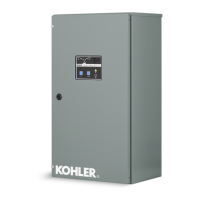TP-6461 1/088 Safety Precautions and Instructions
Grounding electrical equipment.
Hazardous voltage can cause
severe injury or death. Electrocution
is possible whenever electricity is
present. Ensure you comply with all
applicable codes and standards.
Electrically ground the generator set,
transfer switch, and related equipment
and electrical circuits. Turn off the main
circuit breakers of all power sources
before servicing the equipment. Never
contact electrical leads or appliances
when standing in water or on wet
ground because these conditions
increase the risk of electrocution.
Welding on the generator set. Can
cause severe electrical equipment
damage. Before welding on the
generator set perform the following
steps: (1) Remove the battery cables,
negative (--) lead first. (2) Disconnect
all engine electronic control module
(ECM) connectors. (3) Disconnect all
generator set controller and voltage
regulator circuit board connectors.
(4) Disconnect the engine battery-
charging alternator connections.
(5) Attach the weld ground connection
close to the weld location.
Installing the battery charger.
Hazardous voltage can cause
severe injury or death. An
ungrounded battery charger may
cause electrical shock. Connect the
battery charger enclosure to theground
of a permanent wiring system. As an
alternative, install an equipment
grounding conductor with circuit
conductors and connect it to the
equipment grounding terminal or the
lead on the battery charger. Install the
battery charger as prescribed in the
equipment manual. Install the battery
charger in compliance with local codes
and ordinances.
Connecting the battery and the
battery charger. Hazardous voltage
can cause severe injury or death.
Reconnect the battery correctly,
positive to positive and negative to
negative, to avoid electrical shock and
damage to the battery charger and
battery(ies). Have a qualified
electrician install the battery(ies).
Short circuits. Hazardous
voltage/current can cause severe
injury or death. Short circuits can
cause bodily injury and/or equipment
damage. Do not contact electrical
connections with tools or jewelry while
making adjustments or repairs.
Remove all jewelry before servicing the
equipment.
Making line or auxiliary
connections. Hazardous voltage
can cause severe injury or death. To
prevent electrical shock deenergizethe
normal power source before making
any line or auxiliary connections.
Servicing the transfer switch.
Hazardous voltage can cause
severe injury or death. Deenergize all
power sources before servicing. Turn
off the main circuit breakers of all
transfer switch power sources and
disable all generator sets as follows:
(1) Move all generator set master
controller switches to the OFF position.
(2) Disconnect power to all battery
chargers. (3) Disconnect all battery
cables, negative (--) leads first.
Reconnect negative (--) leads lastwhen
reconnecting the battery cables after
servicing. Follow these precautions to
prevent the starting of generator sets
by an automatic transfer switch, remote
start/stop switch, or engine start
command from a remote computer.
Before servicing any components
inside the enclosure: (1) Remove all
jewelry. (2) Stand on a dry, approved
electrically insulated mat. (3) Test
circuits with a voltmeter to verify that
they are deenergized.
Testing live electrical circuits.
Hazardous voltage or current can
cause severe injury or death. Have
trained and qualified personnel take
diagnostic measurements of live
circuits. Use adequately rated test
equipment with electrically insulated
probes and follow the instructions of the
test equipment manufacturer when
performing voltage tests. Observe the
following precautions when performing
voltage tests: (1) Remove all jewelry.
(2) Stand on a dry, approved electrically
insulated mat. (3) Do not touch the
enclosure or components inside the
enclosure. (4) Be prepared for the
system to operate automatically.
(600 volts and under)
Removing the transfer switch from
bypass/isolation models.
Hazardous voltage can cause
severe injury or death. Bypass and
isolate the transfer switch before
removing it from the enclosure. The
bypass/isolation switch is energized.
Do not touch the isolation contact
fingers or the control circuit terminals.
Heavy Equipment
Unbalanced weight.
Improper lifting can cause severe
injury or death and equipment
damage.
Use adequate lifting capacity.
Never leave the transfer switch
standing upright unless it is securely
bolted in place or stabilized.
WARNING
Moving Parts
Spring-loaded parts.
Can cause severe personal injury
or property damage.
Wear protective goggles when
servicing spring-loaded parts. Hold
parts securely during disassembly.
WARNING
Disassembling the solenoid.
Spring-loaded parts can cause
severe personal injury or property
damage. The spring in the solenoid
assembly exerts substantial force on
the coil. Hold the coil assembly
securely when removing the screws.
Notice
NOTICE
Hardware damage. The transfer
switch may use both American
Standard and metric hardware. Use
the correct size tools to prevent
rounding of the bolt heads and nuts.

